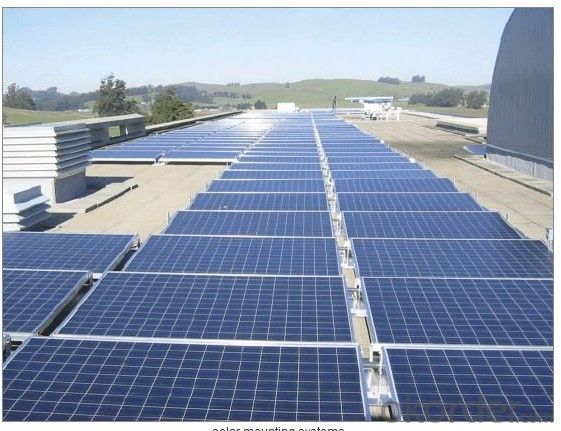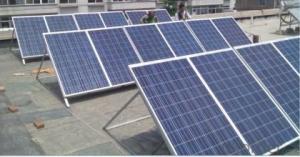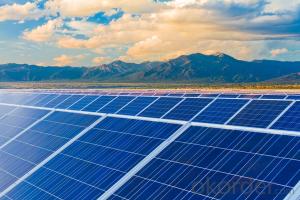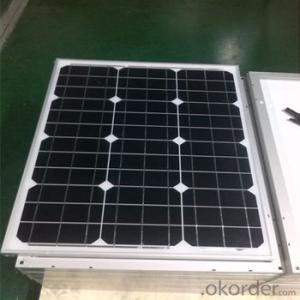(45-50W) CNBM Solar Polycrystalline 6 Series
- Loading Port:
- China main port
- Payment Terms:
- TT OR LC
- Min Order Qty:
- 100000 watt
- Supply Capability:
- 10000000 watt/month
OKorder Service Pledge
OKorder Financial Service
You Might Also Like
Solar cell module production process
Line called packaging line components, packaging is the production of solar cells a key step in the packaging process without a good, multi-well battery is also not a good component of production boards. Battery package not only the battery life is guaranteed, but also to enhance the combat strength of the battery. Product quality and high service life is to win can be the key to customer satisfaction, so the quality of components of the package board is very important. Mono-crystalline solar module is the core part of solar power systems, as well as the most important part of the solar system. Mono-crystalline solar module consists of high efficiency crystalline silicon solar cell, super white cloth grain toughened glass, EVA, transparent TPT backboard and the composition of aluminum alloy frame. The function of Mono-crystalline solar module is to convert solar energy into electric energy, or sent to the storage battery, or promote work load. The quality of the solar energy battery components and cost will directly decide the quality and cost of the whole system.
Process is as follows:
1, the battery test
2, positive Welding - Inspection –
3, on the back of cascading - Inspection –
4, laying (glass cleaning, material cutting, glass pre-processing, laying) –
5, laminating –
6, to flash ( to the side, cleaning) –
7, fitted border (glue, loading angle keys, punching, install box, scrub I glue) –
8, the welding junction box –
9, high-pressure test –
10, component testing -- -
11 appearance inspection, packaging and storage;

Data sheet
| Characteristics | |
| Max Power Voltage Vmp (V) | 17.4V-17.6V |
| Max Power Current Imp (A) | 2.59A-2.85A |
| Open Circuit Voltage Voc (V) | 22.4V-22.5V |
| Short Circuit Current Isc (A) | 2.77A-3.04A |
| Max Power Pm (W) | 40W-50W |
| Temperature Coefficient of Cells | |
| NOCT | 47℃±2℃ |
| Temperature Coefficients of Isc (%/℃) | 0.06% |
| Temperature Coefficients of Voc (%/℃) | -0.33% |
| Temperature Coefficients of Pmp (%/℃) | -0.45% |
| Mechanical Data | |
| Type of Cells (mm) | Poly156×52 |
| Dimension | 700×510×30mm |
| Weight | 4.5kg |
| NO.of Cells and Connections | 3×12=36 |
| Limits | |
| Operating Temperature | –45°C to +80°C |
| Storage Temperature | –45°C to +80°C |
| Max System Voltage | 700V |
FAQ:
1. How long will my inquiry get response?
Your inquiry related to our products or prices will be replied within 24 hours.
2. Can I get professional service and suggestion?
Well-trained and experienced staffs to answer all your questions in fluent English.
3. Do you accept OEM or customized design?
OEM & ODM, any your customized lightings we can help you to design and put into product.
4. What if I need specific design?
Distributorship are offered for your unique design and some our current models.
- Q:can this amount of solar charge these batteries.
- Well you are stating the solar panel powers but no mention of their voltage??. Yes, they should do the job. I suspect the lack of blocking diodes may be your problem, assuming you have done the homework. You have 6 battery cells at 2 volts each, that is ...err..2 volts, assuming you have them connected in series. Count the number of cells on the solar panels and maybe we have a starting point. One solar cell is 0.6 v, in this case you would need a minimum of around 30 cells (physically it will probably be 32 to make it 'square'), you need a fair bit of over- sizing in that direction. Solar panels are resistive when not illuminated so must have a blocking diode included to prevent the batteries from discharging into the solar panels at night. Check that each array has a blocking diode included, if not add them. Solar power is pretty useless unless you have loads of sunshine. You seem to have gone through a bit of trouble and expense on this one, so give me some basic facts and I will help you through it. Update 7 Dec If the batteries take 20 hours to fully charge and there are 0 hours of sun each day then the batteries will be fully charged in 2 days. The question was, can the battery be charged, answer is yes, it can. There is no mention of load. If the batteries are not charging there is something wrong.
- Q:Can solar panels be connected directly to motor?
- The sun is irradiated on the semiconductor p-n junction to form a new hole-electron pair. Under the action of the p-n junction electric field, the holes flow from the n region to the p region. The electrons flow from the p region to the n region, and the current is formed after the circuit is turned on.
- Q:Can solar panels be installed on historical landmarks or monuments?
- Yes, solar panels can be installed on historical landmarks or monuments. However, it requires careful planning and consideration to ensure that the installation does not compromise the integrity or aesthetics of the site.
- Q:Can solar panels be used for irrigation systems?
- Yes, solar panels can be used for irrigation systems. Solar panels can generate electricity which can power the pumps and other components of an irrigation system, reducing the reliance on traditional power sources and making it a more sustainable and cost-effective solution.
- Q:What is the impact of snow accumulation on solar panels' performance?
- Snow accumulation on solar panels has a negative impact on their performance. The layer of snow blocks sunlight from reaching the panels, reducing their ability to generate electricity. Additionally, snow can also add weight and potentially damage the panels if not cleared promptly. Therefore, regular snow removal is necessary to ensure optimal functioning of solar panels.
- Q:we are planing to move out of the grid. we need to operate constantly 2 laptops online - does any one can tell us how much solar panels we shall need to make sure of that?
- A laptop is about 70 to 00 W, and you have two. You also may need to power a router, and modem. So, about 50W to 250W contineous should cover it. To save power when not in use, you can let the display go blank. This will reduce your solar pannel, and battery size, and cost. You will need batteries, and blocking rectifier to store the energy for use at night, and a 300W to 400W inverter. Checkout the link below for purchasing solar equipment. You can only hope to get about 8 to 9 hours of full output from your solar pannels, and 80% efficiency. The laptops will be on and using about 200W for the 8 hours during the charging period. So your pannels, need to produce that plus 2 times more than this amount, so you can charge the batteries for the evening, at the same time. So for 24 hour operation, you will need 200W x8hrs for the laptops, plus (6 hours*70W)/8=340W avg. Total of ~540W for 8 hours. Assuming you use power saving modes when not in use, you can probably get away with 3x60W -- 520W to 600W pannel. ( Thuja is right, a few cloudy days may knock you offline) Batteries. A common low cost ( $40) automotive battery can hold about 40 Amp/hours at 2V. Under load, you may get 35 Amp hours at 0V, which is about 350Watts for one hour. You need about 80W avg for 6 hours, or ~ 2900Watt Hours. Which means you would need 9 automotive batteries. Deep storage batteries cost more, but are more durable. 6*00W pannels, $460*6 ~ $2800 Inverter $70 Batteries $400 Battery cables, rectifier, lugs, connectors $50 There are probably some other hidden costs. I was rooting for you, but it appears to be pricey. Another thing you can do, is to use the new energy efficient RF florescent bulbs for lighting. The color and brightness are excellent, and a 60W bulb only uses about 3W, and they last a lot longer as well.
- Q:ASAP :) as much details as possible
- Build okorder /
- Q:Can solar panels be used in areas prone to hurricanes or earthquakes?
- Yes, solar panels can be used in areas prone to hurricanes or earthquakes. While these natural disasters can pose challenges, solar panels are designed to withstand extreme weather conditions. They are built with durable materials and undergo rigorous testing to ensure their ability to withstand high winds, heavy rain, and even minor earthquakes. Additionally, proper installation techniques and maintenance practices can enhance their resilience in these areas.
- Q:Can solar panels be used to power outdoor lighting?
- Yes, solar panels can be used to power outdoor lighting. Solar panels convert sunlight into electricity, which can be stored in batteries or used directly to power outdoor lights such as garden lights, pathway lights, or streetlights. This allows for environmentally friendly and cost-effective lighting solutions in outdoor areas.
- Q:I need to reduce the average monthly home electricity bill by powering some of the household appliances using solar panels. Can I use a 250 watt solar panel to power a medium sized upright fridge?
- Solar panel alone? No. With the appropriate storage system and inverter, perhaps. You will need to do the calculation - as follows: In a solar day that averages about eight hours, you will generate about 67% of your rated output over those 8 hours. That means you will have made 340 watts. Your refrigerator will run for about four (4) hours per day on average if you are very careful about opening and closing. If you have a 400-watt (average-when-running) fridge, you will have a small cushion that will be absorbed by inverter losses, charger losses and so forth. So, with an adequate set of storage batteries, a good charger and a good inverter, you just might be able to operate that small fridge. No icemaker, no other power drains. But, two 250-watt panels would be better.
1. Manufacturer Overview |
|
|---|---|
| Location | |
| Year Established | |
| Annual Output Value | |
| Main Markets | |
| Company Certifications | |
2. Manufacturer Certificates |
|
|---|---|
| a) Certification Name | |
| Range | |
| Reference | |
| Validity Period | |
3. Manufacturer Capability |
|
|---|---|
| a)Trade Capacity | |
| Nearest Port | |
| Export Percentage | |
| No.of Employees in Trade Department | |
| Language Spoken: | |
| b)Factory Information | |
| Factory Size: | |
| No. of Production Lines | |
| Contract Manufacturing | |
| Product Price Range | |
Send your message to us
(45-50W) CNBM Solar Polycrystalline 6 Series
- Loading Port:
- China main port
- Payment Terms:
- TT OR LC
- Min Order Qty:
- 100000 watt
- Supply Capability:
- 10000000 watt/month
OKorder Service Pledge
OKorder Financial Service
Similar products
New products
Hot products
Hot Searches
Related keywords






























